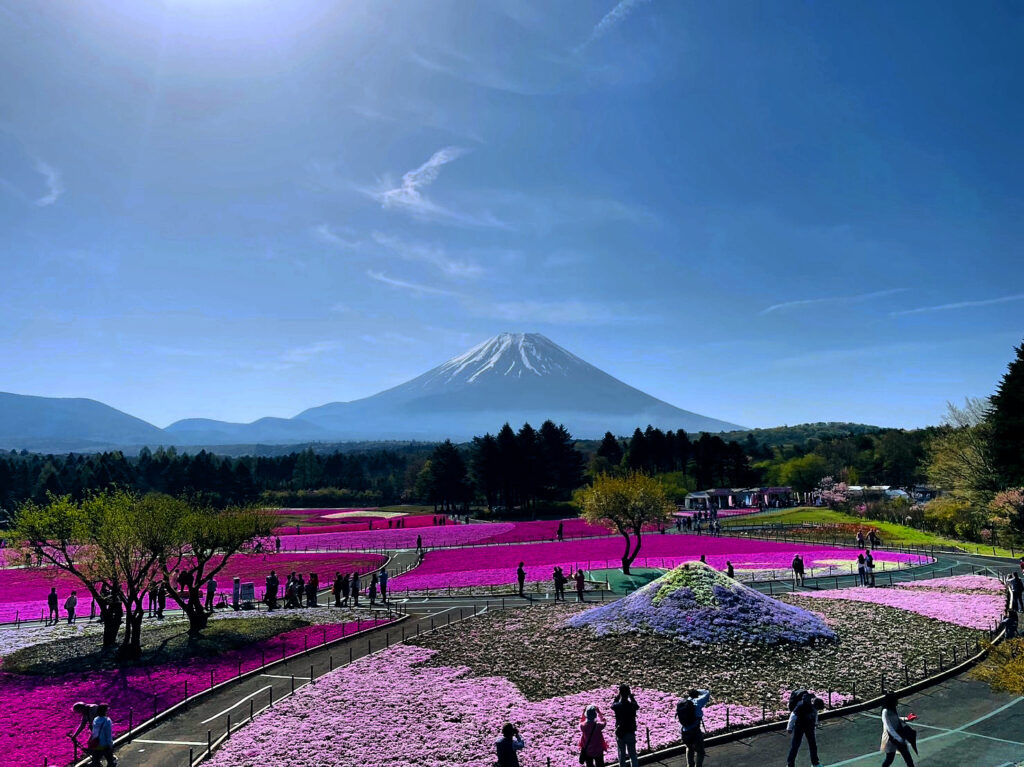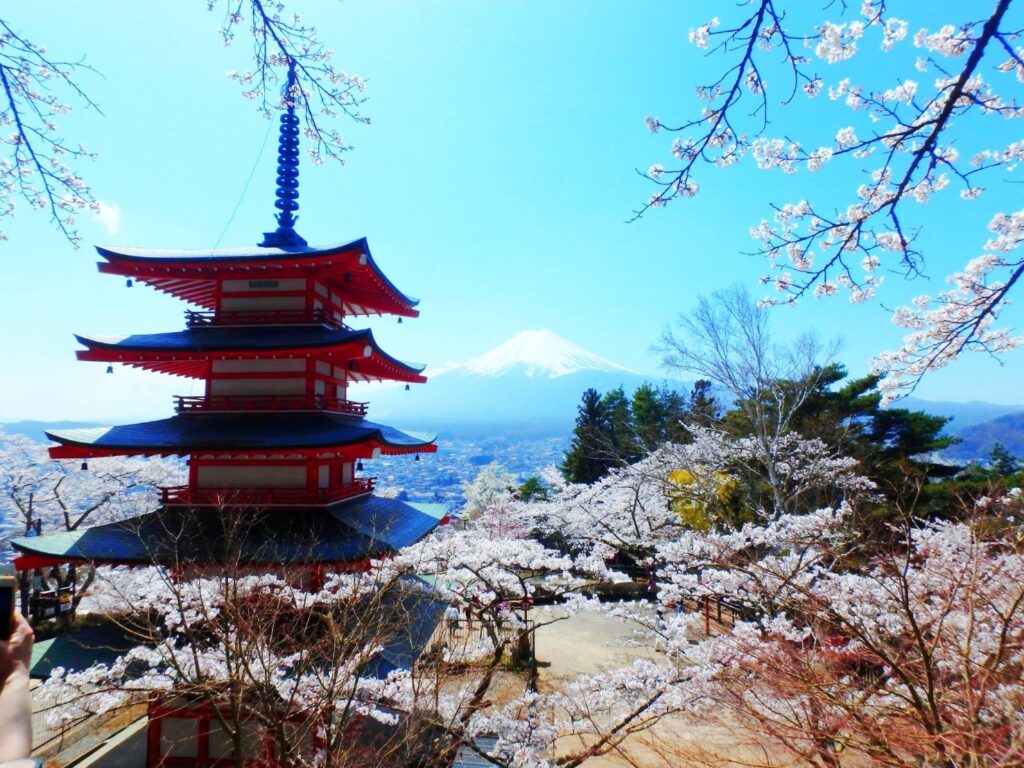I’m a local Japanese living in the Kawaguchiko area, and every autumn I look forward to the beautiful fall colors around Mt. Fuji. One of the most famous spots is the Momiji Tunnel (Maple Corridor), where rows of red and yellow maple trees create a stunning pathway along the river.
I visited the Momiji Tunnel myself during the peak season, and in this article I’ll share my honest experience—what it looked like, how crowded it was, and my tips for the best time to go. This isn’t just another travel guide; it’s a local’s perspective on what it really feels like to walk through Kawaguchiko’s most popular autumn leaves spot.
Quick Navigation
Why I Wanted to Visit the Momiji Tunnel

Autumn in Kawaguchiko as a Local
Living in Kawaguchiko, I always notice how the town changes with the seasons, but autumn is truly special. The air turns crisp, the lake feels calmer, and Mt. Fuji often appears with its first snow cap of the year. For locals, autumn means more than just sightseeing—it’s the time when we enjoy slower walks by the lake, seasonal food like hōtō noodles, and of course, the famous autumn leaves.
Even though I see Mt. Fuji almost every day, the combination of bright red maple trees and the mountain together always feels fresh and exciting. It’s the kind of scenery that makes you stop and take it in, even if you’ve lived here for years.
Expectations Before Going
Before visiting the Momiji Tunnel, I had heard from both locals and tourists that it was the highlight of autumn in Kawaguchiko. I expected beautiful maple trees lining the walkway, but I also knew it could be very crowded—especially in the evening when the trees are lit up.
What I was most curious about was whether it would feel worth the hype. Would it be just another touristy spot, or would it really capture the spirit of autumn in Kawaguchiko? With those thoughts in mind, I decided to go and see it for myself.
My Visit to the Momiji Tunnel
First Impressions When I Arrived
When I first arrived at the Momiji Tunnel, the scene immediately felt lively and festive. Rows of tall maple trees lined the walkway, their red and yellow leaves creating a natural canopy overhead. The air was crisp, and you could hear the sound of cameras clicking everywhere. Even though I had seen photos before, standing there in person felt much more powerful—the colors were richer, and the setting with Mt. Fuji in the background was almost surreal.
The Atmosphere – Crowds, Colors, and the Evening Light-Up
As I walked deeper into the tunnel, I quickly realized how popular this spot really is. By late afternoon and especially around the evening light-up, the path became packed with people. It was hard to take photos without someone in the frame, but at the same time the atmosphere was full of excitement, almost like a festival.
The light-up itself was beautiful—the maple leaves glowed in shades of orange and red under the lanterns, creating a warm and almost magical scene. It was crowded, but when I looked up and saw the leaves illuminated against the night sky, I understood why so many people come here. It felt like a special seasonal moment that you can only experience once a year in Kawaguchiko.
What Stood Out the Most for Me
What impressed me the most about the Momiji Tunnel wasn’t just the bright red and golden leaves—it was the way the scenery changed depending on the time and angle. During the day, the maple trees looked vibrant and cheerful, but in the evening they turned into something completely different, glowing under the lights with a calm, almost mystical atmosphere.
Another thing that stood out was how the view framed Mt. Fuji in the distance. Even though it was crowded, there were still small moments when I could pause, look up through the tunnel of leaves, and see the mountain perfectly aligned behind them. That combination of autumn colors and Mt. Fuji is something you can’t really capture fully in photos—it’s a memory that stays with you long after the visit.
Tips for Enjoying the Momiji Tunnel
Best Time of Day to Visit (Morning vs. Evening)
From my experience, mornings are the best time if you want a quieter walk through the Momiji Tunnel. The colors are still beautiful in the daylight, and you can actually take your time without rushing. By evening, the atmosphere completely changes—the light-up makes the trees glow in warm red and orange, but it also brings in the biggest crowds. Personally, I enjoyed the morning for peace and the evening for the festive atmosphere, so it depends on what kind of experience you want.
Weekday vs. Weekend – How Crowded It Gets
Weekends are by far the busiest. I’ve seen long lines of people slowly moving through the tunnel, especially on Saturdays during peak season. On weekdays, it’s still popular, but much more manageable—you can find moments to enjoy the view without being surrounded by too many people. If your schedule allows, visiting on a weekday will make the experience far more comfortable.
Access and Parking – What I Learned
The Momiji Tunnel is close to central Kawaguchiko and easy to reach by car or bus. That said, parking can be tricky during the peak season. There are some small parking lots nearby, but they fill up quickly, especially in the evening. I found it easier to use parking areas a bit farther from the site and walk about 10–15 minutes. Another option is to use the local sightseeing bus, which stops near the tunnel and saves you the hassle of finding parking.
How This Experience Felt Different from Other Lakes
Comparing With My Visits to Saiko or Shoji
Having visited other lakes like Saiko and Shoji, I noticed a big difference in the atmosphere. Those lakes are usually much quieter, with fewer tourists, so the experience feels more peaceful and personal. At Saiko and Shoji, I could walk along the lakeside almost alone, taking in the autumn scenery without distraction.
In contrast, Kawaguchiko’s Momiji Tunnel was far more crowded and lively. It felt less like a quiet nature walk and more like a seasonal event. While I sometimes prefer the calm of Saiko or Shoji, the energy at Kawaguchiko gave me a different kind of excitement—it was like celebrating autumn together with many other people.
👉 What is Lake Shoji?I want to know about Lake Shoji!
👉 I want to know about Lake Saiko!
Why Kawaguchiko’s Autumn Leaves Felt Special
What made Kawaguchiko’s autumn leaves stand out was the combination of maple trees and Mt. Fuji. Seeing the bright red leaves framing Japan’s most iconic mountain created a picture-perfect scene that I couldn’t find at the other lakes. The scale of the Momiji Tunnel, with so many trees glowing under the evening lights, also made it unique.
Even though it was crowded, I felt that Kawaguchiko’s autumn leaves offered a once-in-a-year experience worth seeing. It’s the kind of place that reminds you why autumn in Japan is so famous, and why people from all over the world come to visit.
Final Thoughts – Why It’s Worth Experiencing Once
My Personal Recommendation
If it’s your first time visiting Kawaguchiko in autumn, I do recommend making the effort to see the Momiji Tunnel at least once. Go in the morning if you want a calmer walk, or in the evening if you want to experience the light-up and the lively atmosphere. Even though it can get crowded, the combination of fall colors and the seasonal energy is something you don’t often experience elsewhere.
Why Autumn Leaves Add Something Extra to a Mt. Fuji Trip
Mt. Fuji is impressive at any time of year, but autumn adds a layer of beauty that makes the trip unforgettable. The snow-capped mountain framed by glowing maple leaves feels like the ultimate “Japan in autumn” scene. For me, walking through the Momiji Tunnel wasn’t just about seeing the leaves—it was about feeling the season, joining the flow of people who came to enjoy it, and realizing how nature and tradition blend together here.
If you’re planning a Mt. Fuji trip in October or November, adding an autumn leaves stop will give you a deeper, more colorful memory of Japan.


